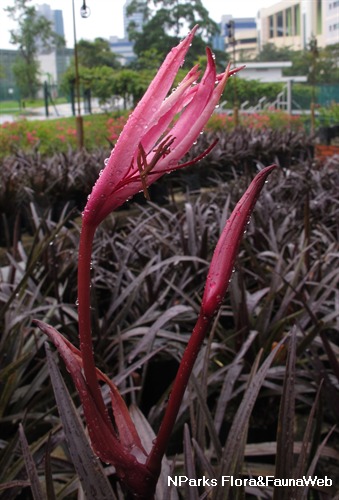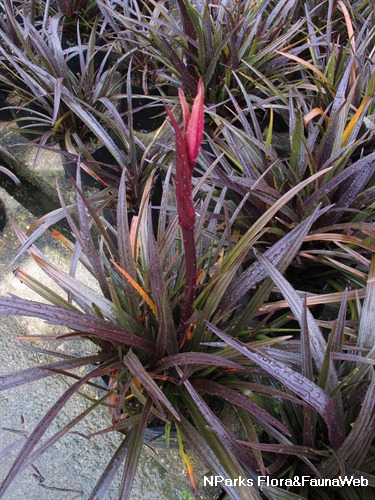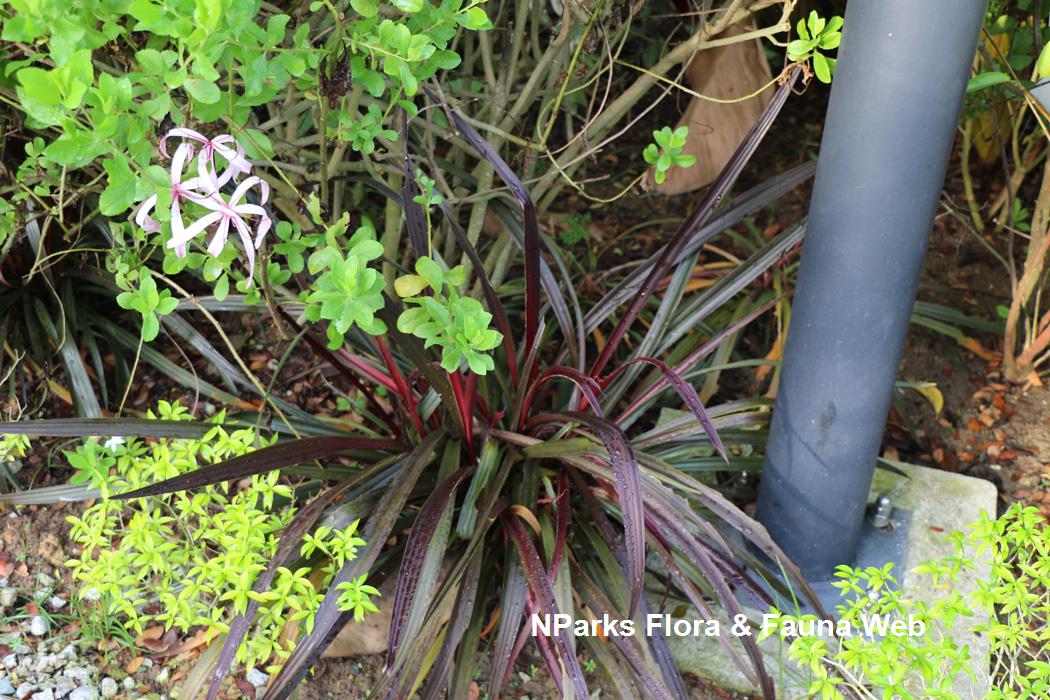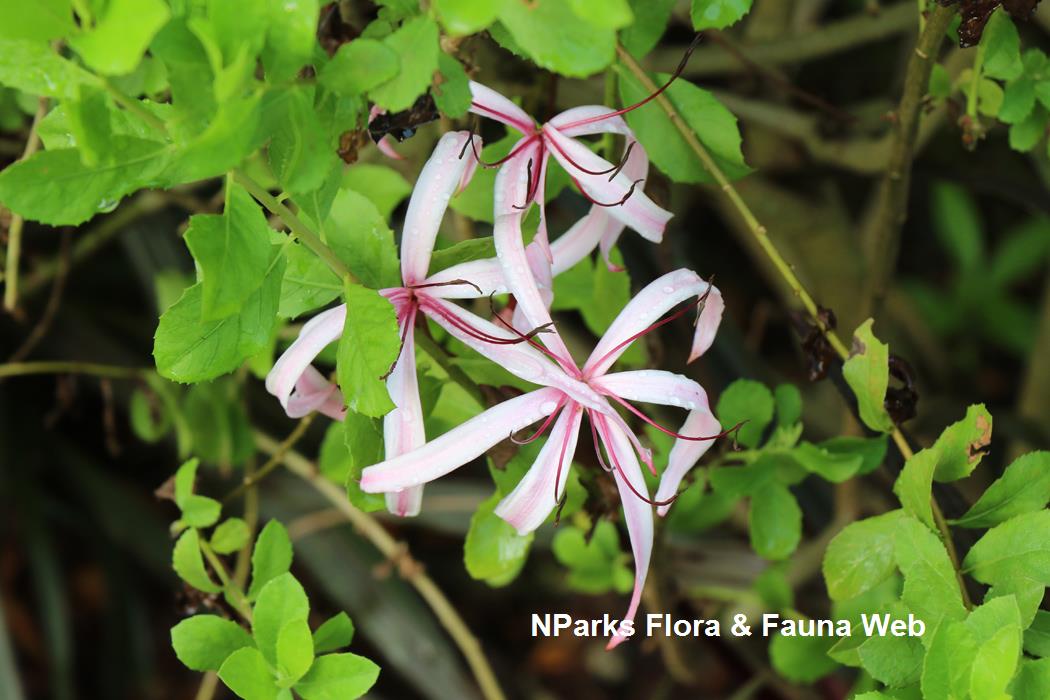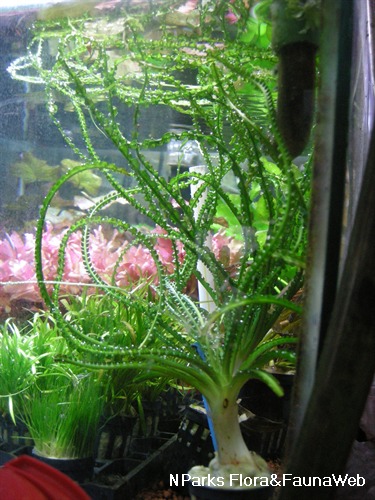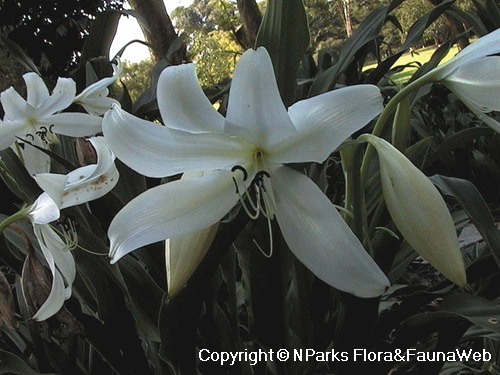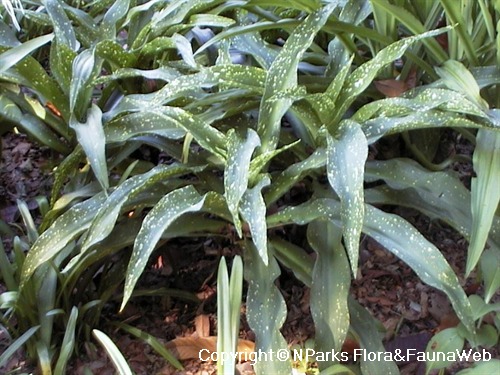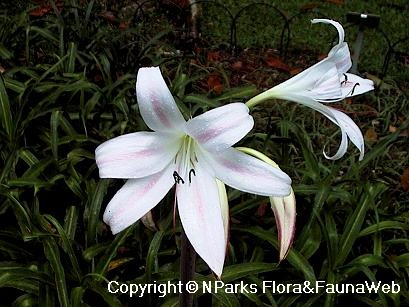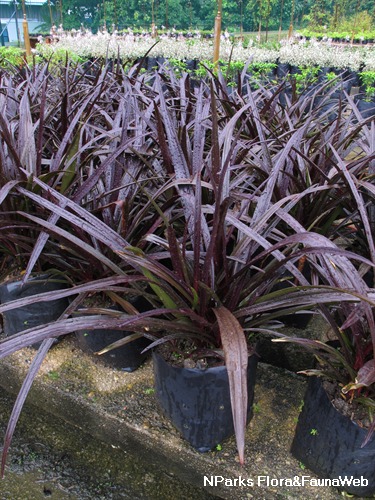
Back
Crinum 'Menehune'
| Family Name: | Amaryllidaceae |
| Common Name: | Red Bog Lily, Red Swamp Lily, Fire & Ice Bog Lily |
Crinum 'Menehune' is a hybrid lily cultivar adapted to the subtropics or tropics. It is special in the sense that it can grow in water up to 15 cm deep and also in the ground. It was introduced by the Hawaii Tropical Botanical Garden.
Name
Classifications and Characteristics
| Plant Division | Angiosperms (Flowering Seed Plants) (Monocotyledon) |
|---|---|
| Plant Growth Form | Herbaceous Plant, Aquatic & Hydrophyte (Emergent Aquatic, Waterside / Marginal) |
| Lifespan (in Singapore) | Perennial |
| Mode of Nutrition | Autotrophic |
| Plant Shape | Compact |
| Maximum Height | 0.6 m to 1 m |
| Maximum Plant Spread / Crown Width | 0.6 m to 1 m |
Biogeography
| Preferred Climate Zone | Tropical |
|---|---|
| Local Conservation Status | Non-native |
Description and Ethnobotany
| Growth Form | A short herbaceous perennial that grows from bulbs and forms clumps up to 0.9 m tall. It is thought to originate from a cross between Crinum amabile and a Crinum species from the Caribbean. |
|---|---|
| Foliage | Dark purplish red, glossy leaves are strap-shaped with pointed leaf apex and entire leaf margin (2.5 - 5 cm wide). They have a slightly pleated leaf surface and are arranged in a rosette. |
| Flowers | Dark pink flowers have 6 narrow, linear petals that are bent backwards and 7 - 8 red, long stamens. Flowers are arranged in an umbellate inflorescence (several stalked flowers united at the base to a single point). The inflorescence is borne on a thick, dark red stalk. |
| Fruit | Dry, dehiscent fruits are known as capsules. Fruits and seeds are both approximately round. |
| Others - Plant Morphology | The underground bulb can grow up to 22 cm wide or more. |
| Cultivation | This cultivar is best grown under full sun so that leaf colour will be better and more flowers will be produced. However, it can tolerate light shade. Specimens should be planted 0.9 - 1.2 m apart in fertile soil mixed with compost . It is tolerant of waterlogged soils. For cultivation as an emergent aquatic plant, the specimen should be potted in a 1 - 3 gallon container and positioned so that the soil surface is 8 - 15 cm below water. It is resistant to most pests, because the leaves contain toxic alkaloids. However, it is susceptible to the black-and-yellow striped amaryllis caterpillar Brithys pancratii and also sometimes attacked by snails and slugs. |
| Etymology | The genus "Crinum" is derived from the Greek word for iris or lily ("krinon"). The cultivar name "Menehune" was named after a mythological race of Hawaiian forest dwellers who were short, dark-skinned and kept to themselves. |
Landscaping Features
| Landscaping | This cultivar is grown for its ornamental foliage and flowers. The leaves remain consistently purplish red, unlike those of Crinum procerum which fade in colour. The dark red leaves will provide contrast against a mostly green landscape. It will thrive in waterlogged areas where many species cannot grow. As as aquatic plant, consider growing it along pond margins or as an emergent aquatic plant. |
|---|---|
| Desirable Plant Features | Ornamental Foliage, Ornamental Flowers |
| Landscape Uses | Pond / Lake / River |
| Thematic Landscaping | Water Garden |
Plant Care and Propagation
| Light Preference | Full Sun |
|---|---|
| Water Preference | Lots of Water |
| Plant Growth Rate | Fast to Moderate |
| Rootzone Tolerance | Fertile Loamy Soils, Waterlogged Soils (Drains Site) |
| Diseases | It is susceptible to the black-and-yellow striped amaryllis caterpillar (Brithys pancratii) and also sometimes attacked by snails and slugs. |
| Pest(s) | Associated with, Chewing Insects |
| Propagation Method | Division, Storage Organ (Bulb), Viviparious Propagule |
| Propagule Establishment Remarks | It can be propagated by dividing the bulbs or removing and replanting daughter plants known as offsets. |
| Propagation Method Remarks | Propagate by dividing the bulbs or replanting offsets. |
| Planting Distance | 0.9 m to 1.2 m |
Foliar
| Foliage Retention | Evergreen |
|---|---|
| Mature Foliage Colour(s) | Red, Purple, Brown |
| Mature Foliage Texture(s) | Glossy / Shiny, Crinkled / Twisted |
| Prominent Young Flush Colour(s) | Purple, Brown, Red |
| Foliar Type | Simple / Unifoliate |
| Foliar Arrangement Along Stem | Rosulate / Rosette |
| Foliar Attachment to Stem | Sessile |
| Foliar Shape(s) | Non-Palm Foliage (Linear) |
| Foliar Venation | Parallel |
| Foliar Margin | Entire |
| Foliar Apex - Tip | Acute |
| Foliar Base | Clasping |
| Typical Foliar Area | Mesophyll ( 45cm2 - 182.25 cm2 ), Macrophyll ( 182.25cm2 - 1640.25 cm2 ) |
| Typical Foliar Size Remarks | Leaf blade is about 2.5 to 5 cm wide and 60 cm long. |
| Mature Foliage Colour(s) Remarks | Foliage is deep reddish-brown. |
| Typical Foliar Size | 60 cm |
Floral (Angiosperm)
| Flower & Plant Sexuality | Bisexual Flowers |
| Flower Colour(s) | Pink |
|---|---|
| Flower Texture(s) | Smooth |
| Flower Grouping | Cluster / Inflorescence |
| Flower Location | Terminal |
| Flower Symmetry | Radial |
| Individual Flower Shape | Stellate / Star-shaped |
| Inflorescence Type | Umbel |
Fruit, Seed and Spore
| Fruit Classification | Simple Fruit |
|---|---|
| Fruit Type | Dehiscent Dry Fruit , Capsule |
Image Repository
Others
| Master ID | 30627 |
|---|---|
| Species ID | 4936 |
| Flora Disclaimer | The information in this website has been compiled from reliable sources, such as reference works on medicinal plants. It is not a substitute for medical advice or treatment and NParks does not purport to provide any medical advice. Readers should always consult his/her physician before using or consuming a plant for medicinal purposes. |

